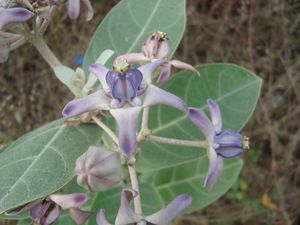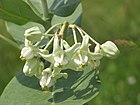Note: This is a project under development. The articles on this wiki are just being initiated and broadly incomplete. You can Help creating new pages.
Calotropis gigantea - Arka plant
Calotropis procera is a large shrub growing to 4m tall. It has clusters of waxy flowers that are either white or lavender in color. This plant is belongs to Aslepiacea family.
Contents
- 1 Uses
- 2 Parts Used
- 3 Chemical Composition
- 4 Common names
- 5 Properties
- 6 Habit
- 7 Identification
- 8 List of Ayurvedic medicine in which the herb is used
- 9 Where to get the saplings
- 10 Mode of Propagation
- 11 How to plant/cultivate
- 12 Commonly seen growing in areas
- 13 Photo Gallery
- 14 References
- 15 External Links
Uses
Rheumatism, Painful joints, Skin blemishes, Leucoderma, Vitiligo, Piles, Pain in ears[1]
Parts Used
Roots, Bark, Flowers, Leaves, Latex.
Chemical Composition
The milky sap contains a complex mix of chemicals, some of which are steroidal heart poisons known as "cardiac aglycones".[2]
Common names
| Language | Common name |
|---|---|
| Kannada | Ekka, Ekkadagida, Ekkegida |
| Hindi | Aak, Akavana, Madar |
| Malayalam | Erikku |
| Tamil | Erukku, Vellerukku |
| Telugu | Jilledu |
| Marathi | Rui |
| Gujarathi | Aakado |
| Punjabi | Ak |
| Kashmiri | Vasa |
| Sanskrit | Bhaanu, Ravi, Tapana, Arka |
| English | Aakado |
Properties
Reference: Dravya - Substance, Rasa - Taste, Guna - Qualities, Veerya - Potency, Vipaka - Post-digesion effect, Karma - Pharmacological activity, Prabhava - Therepeutics.
Dravya
Rasa
Tikta (Bitter), Katu (Pungent)
Guna
Laghu (Light), Sara, Snigdha
Veerya
Ushna (Hot)
Vipaka
Katu (Pungent)
Karma
Vatahara, Kaphahara, Bhedana, Deepana, Kshamighna
Prabhava
Habit
Identification
Leaf
| Kind | Shape | Feature |
|---|---|---|
| Simple | Opposite | Elliptic-ovate to obovate, greyish-green in colour and have entire margins, relatively thick (5-30 cm long and 4-15 cm wide) with a cordate leaf base. Secondary veins 5-7 pairs |
Flower
| Type | Size | Color and composition | Stamen | More information |
|---|---|---|---|---|
| Borne in clusters | 15-25 mm across | White or Purplish | Five | Flowering occurs mostly during winter |
Fruit
| Type | Size | Mass | Appearance | Seeds | More information |
|---|---|---|---|---|---|
| Large | 6-12 cm long and 3-7 cm wide | These fruit have thick and spongy skins which split open at maturity | Flattened seeds |
Other features
List of Ayurvedic medicine in which the herb is used
- Vishatinduka Taila as root juice extract
Where to get the saplings
Mode of Propagation
How to plant/cultivate
Succeeds in the drier tropics. Most commonly found in areas of the tropics with a specific dry season, at elevations up to 1,000 metres.[5]
Commonly seen growing in areas
Tropical area, Indian subcontinent.
Photo Gallery
References
- ↑ Medicinal uses of Madar
- ↑ Chemical Composition
- ↑ Karnataka Aushadhiya Sasyagalu By Dr.Maagadi R Gurudeva, Page no:245
- ↑ Kappatagudda - A Repertoire of Medicinal Plants of Gadag pdf, Page no - 89
- ↑ Cultivation Details
External Links
- Ayurvedic Herbs known to be helpful to treat Rheumatism
- Ayurvedic Herbs known to be helpful to treat Painful joints
- Ayurvedic Herbs known to be helpful to treat Skin blemishes
- Ayurvedic Herbs known to be helpful to treat Leucoderma
- Ayurvedic Herbs known to be helpful to treat Vitiligo
- Ayurvedic Herbs known to be helpful to treat Piles
- Ayurvedic Herbs known to be helpful to treat Pain in ears
- Herbs with Roots used in medicine
- Herbs with Bark used in medicine
- Herbs with Flowers used in medicine
- Herbs with Leaves used in medicine
- Herbs with Latex used in medicine
- Herbs with common name in Kannada
- Herbs with common name in Hindi
- Herbs with common name in Malayalam
- Herbs with common name in Tamil
- Herbs with common name in Telugu
- Herbs with common name in Marathi
- Herbs with common name in Gujarathi
- Herbs with common name in Punjabi
- Herbs with common name in Kashmiri
- Herbs with common name in Sanskrit
- Herbs with common name in English
- Habit - Large shrub
- Index of Plants which can be propagated by Seeds
- Index of Plants which can be propagated by Cuttings
- Index of Plants which can be propagated by Layering
- Herbs that are commonly seen in the region of Tropical area
- Herbs that are commonly seen in the region of Indian subcontinent
- Ayurvedic Pharmacopedia of India
- Herbs
- Ayurvedic herbs that don't have seed photos
- Apocynaceae




